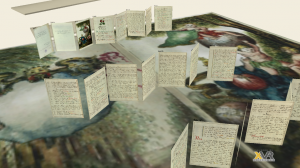MUBIL: A Digital Library
DemonstrationMarina Belli, Italy
C. Lorenzini1, M.Belli1, C.Evangelista1, M.Carrozzino1, A. Angeletaki2
1 PERCRO Perceptual Robotics Laboratory – Scuola Superiore Sant’Anna
Via Alamanni 13b, 56017 Ghezzano San Giuliano Terme, Pisa, Italy
2 Norwegian University of Science and Technology (NTNU)
University library, Gunnerus branch, Trondheim, Norway
MUBIL is an international interdisciplinary collaboration project between the NTNU University Library of Trondheim, PercRo laboratory of Scuola Superiore Sant’Anna of Pisa and the Department of Computer Information Science of NTNU, Trondheim.The main focus of the project was to investigate new paths of communication between the library and its public using 3D technology as a tool of dissemination. The project applications were completed in October 2013 and are now launched as a workshop concept for schools in Norway.
The library has provided a set of digitized content from the historical collections, of the Gunnerus branch, that is books, manuscripts and background narratives. At first, we realized a touch book that presents itself as a simple 3D digital copy of the original manuscript. In this application, users are enabled to browse, see, zoom and pan the original pages of the manuscript and to access the transcription of the book pages in a more readable format available in many translations.
Then, we add more information on the book, like images, 3D models and texts, audios and videos, realizing a real augmented book. All of the elements added can be used combined together and activated clicking on a single hot-spot.
The proposed concept is adaptable to almost all books, as it separates the application engine (the book with its access features, realized with an XVR application) and the description of the content (the book text and the related material, described with an XML file and a set of multimedia resources). The XVR application first interprets the content and then renders it on a 3D scene. Two Augmented Books have thus been realized: one is a XVI century Medicinal Distillation manual by Adam Lonicer and the other is a XVII century travel journal by Hans Hansen Lilienskiold.
The first one is a printed book while the second one is a handwritten manuscript with watercolor drawings. Comparing these two applications we concluded that the XVR concept is more suitable for books as the first one, with plenty of beautiful colored illustrations, reconstructed as 3D objects, but not as suitable for books with little drawings and more texts, as the second one.
We needed thus, an alternative concept to represent the content of the second manuscript in a three-dimensional environment and create a feeling of travel in time and space. For that we realized an alternate version of the travel journal, using Information Landscapes paradigm.
ILs are abstract Virtual Environments which do not correspond to any real environment, made up of text enriched with 3D and multimedia elements, and exploit the three-dimensional context to map spatial into semantic relationships. ILs are particularly interesting when it’s possible to dispose the information on the space with a selected criteria. For the travel journal case we chose the narrative of visiting the city of Pisa in 1770 and put the information in an abstract reconstruction of the city of Pisa with illustrations and 3-D models that reconstruct the particular section of the journal.
Both 3D books are available for desktop, tablets and immersive environments (like Powerwalls or PercRo CAVEs), and it’s possible to interact with them using a wide choice devices such as mouse, joystick, kinect or wand. Mubil introduces a paradigm shift of reading a book as a rich immersive experience and contributes to the debate around the challenges posed by the increasing potential of the digitalization of historical heritage objects, as archives.



